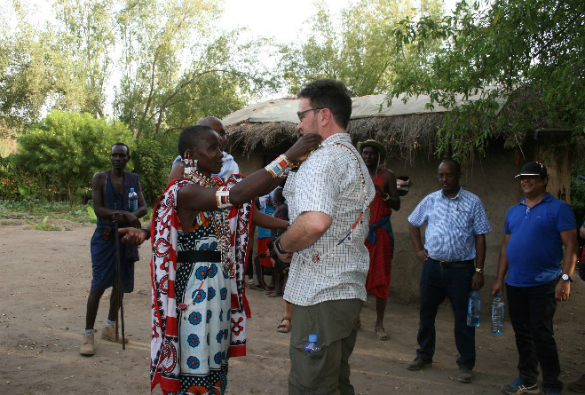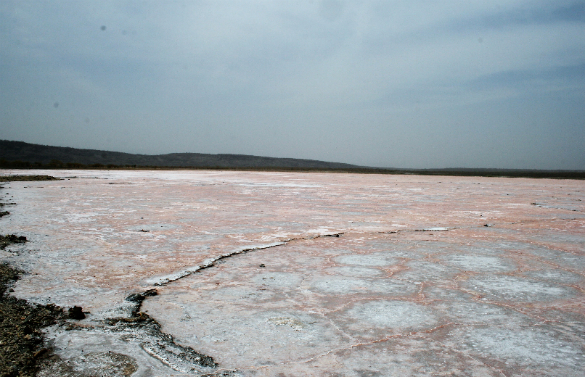
Professor Rob Christley receiving his gift from the Masai.
Nicola Williams is a Professor of Zoonotic Bacteria Disease in the University’s Institute of Infection and Global Health.
“Recently, I visited Nairobi, Kenya to take part in the inaugural meeting for the One Health Regional Network for the Horn of Africa project (HORN).
HORN brings together partners from University of Liverpool, Liverpool School of Tropical Medicine, Kenya, Ethiopia, Eritrea and Somaliland and is funded by the Global Challenges Research Fund. Its aim is to improve the health and wealth of people in the Horn of Africa by increasing capacity to undertake ‘One Health’ research in this region.
Day one of our two-day meeting involved presentations from the different academic partners, and also included governmental and non-governmental organisations involved in the project, such as the Food and Agricultural Organization of the United Nations (FAO).
HORN is a multidisciplinary project, involving vets, medics, microbiologists, epidemiologists, social scientists, climatologists, archaeologists, economists and research capacity scientists. It was therefore really interesting to hear during the breakout sessions what the priorities were both for training and research from local and disciplinary perspectives.
Day two was more focused and involved hearing about potential field study sites in Kenya and Ethiopia, and further discussion around the challenges ahead, including how to monitor and evaluate our progress to ensure we achieve impact through HORN – this involved learning a lot about the ‘theory of change’. HORN is also unique in that it will not just concentrate on researchers at different academic levels, but will build capacity for research by providing leadership training, training of support staff and, also, training of laboratory technicians. The two days provided a real opportunity to get to know our partners better and define our priorities, but it was also good to finish off the meeting socially with a very good curry and a local beer.
The next day we got an opportunity to visit a potential field study site at the Nguruman Escarpment in the south of Kenya. I was really excited by the visit as it was my first trip outside of Nairobi and it was a good opportunity to see rural areas with livestock and learn more about pastoralist production systems and disease challenges. On the way we got to visit Lake Magadi, a soda lake which has a small town and processing factory on its shores and gives way to a surreal landscape, taking you past what looks like snow covered fields. Further on however, the lake takes on the look of lunar landscape and is covered with a pink and grey crust, eventually giving way to open water, which hosts a flock of flamingos. Unfortunately, from our view point and due to a road collapse, we could only see them in the far distance.
Further on we came down into the valley leading to Nguruman, with the landscape becoming less arid and much greener, with a greater abundance of livestock. We arrived mid-afternoon at our guest house in the small town of Entasopia where we were met by two members of the local Masai community. We then had the opportunity to visit a local Masai farm and heard about the impact of the 3 year drought and how the Masai, who traditionally herd cattle, had diversified into arable production. Arable farming provides them with an opportunity to increase their income, growing tomatoes, okra and mangoes which they supply to local markets, or via brokers to Nairobi. Whilst they are having success in growing crops, they acknowledged that this is something they have little expertise in and are facing issues around crop management, disease and encroachment from wildlife.
We were also really lucky to be given a colourful and warm Masai welcome with dancing and singing and introductions to different members of the local community. We were all very touched with the generosity of the community, presenting us with locally made gifts and meat from a goat which they had slaughtered in our honour.
After we left the farm we visited the local wildlife conservancy and headed for a watering hole to see if we could spot some wildlife. The conservancy provides a source of income for the Masai who often work as tourist guides however, the income from visitors also supports the local school and hospital. Although it was getting dark we did manage to see some wildlife and I was pretty amazed by our Masai guides and how they knew the area even in complete darkness.
After returning to our guesthouse we sat out under a very impressive dark sky and got to hear some stories about Masai culture, including how, in the past, young men had to prove themselves by killing a lion. We were also able to discuss more about issues around human and livestock disease.
The next day after breakfast we headed back to Nairobi, but stopped at Olorgesailie, an archaeological site in the Rift Valley famous for the large number of hand axes found there. Luckily we had our own archaeologist, Professor Keith Dobney and anthropologist, Professor Jude Robinson who were able to tell us all about Homo erectus and why the site was so important.
Sadly, that night we had to fly back to the UK – luckily we had the chance to wash off the dust before heading to the airport. I really enjoyed the meeting and the experience of the field trip and I am really looking forward to being part of this exciting project.”
For more about the HORN please visit the project website.


